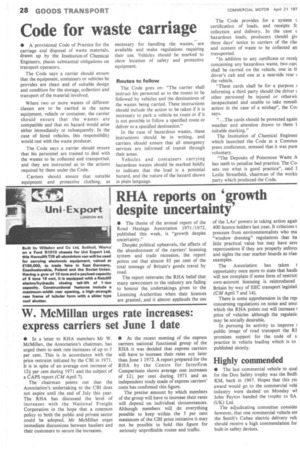Code for waste carriage
Page 30

If you've noticed an error in this article please click here to report it so we can fix it.
• A provisional Code of Practice for the carriage and disposal of waste materials, drawn up by the Institution of Chemical Engineers, places substantial obligations on transport operators.
The Code says a carrier should ensure that the equipment, containers or vehicles he provides are clean and of suitable design and condition for the storage, collection and transport of the material involved.
Where two or more wastes of different classes are to be carried in the same equipment, vehicle or container, the carrier should ensure that the wastes are compatible and that no hazard would arise either immediately or subsequently. In the case of hired vehicles, this responsibility would rest with the waste producer.
The Code says a carrier should ensure that his personnel are trained to deal with the wastes to be collected and transported, and they are instructed as to the actions required by them under the Code.
Carriers should ensure that suitable equipment and protective clothing, as
necessary for handling the wastes,are available and make regulations requiring their use. Vehicles should be marked to show location of safety and protective equipment.
Routes to follow The Code goes on: "The carrier shall instruct his personnel as to the routes to be followed by vehicles and the destinations of the wastes being carried. These instructions should include the action to be taken if it is necessary to park a vehicle en route or if it is not possible to follow a specified route or deliver to a specified destination."
In the case of hazardous wastes, these instructions should be in writing, and carriers should ensure that all emergency services are informed of transit through their areas.
Vehicles and containers carrying hazardous wastes should be marked boldly to indicate that the load is a potential hazard, and the nature of the hazard shown in plain language. The Code provides for a system c certification of loads, and receipts fc collection and delivery. In the case c hazardous loads, producers should giv three days' notice to carriers of the cla5. and content of waste to be collected an transported.
"In addition to any certificate or receit concerning any hazardous waste, two carc shall be carried on the vehicle, one in ti driver's cab and one at a nearside rear the vehicle.
"These cards shall be for a purpose informing a third party should the driver ( other personnel be injured or otherwi incapacitated and unable to take remedi action in the case of a mishap", the Co( says.
"...The cards should be protected again weather and attention drawn to them t suitable marking."
The Institution of Chemical Engineer which launched the Code at a Commoi press conference, stressed that it was pure voluntary.
"The Deposits of Poisonous Waste A has teeth to penalize bad practice. The Col sets out what is good practice", said I Leslie Streatfield, chairman of the workii party which produced the Code.












































































































